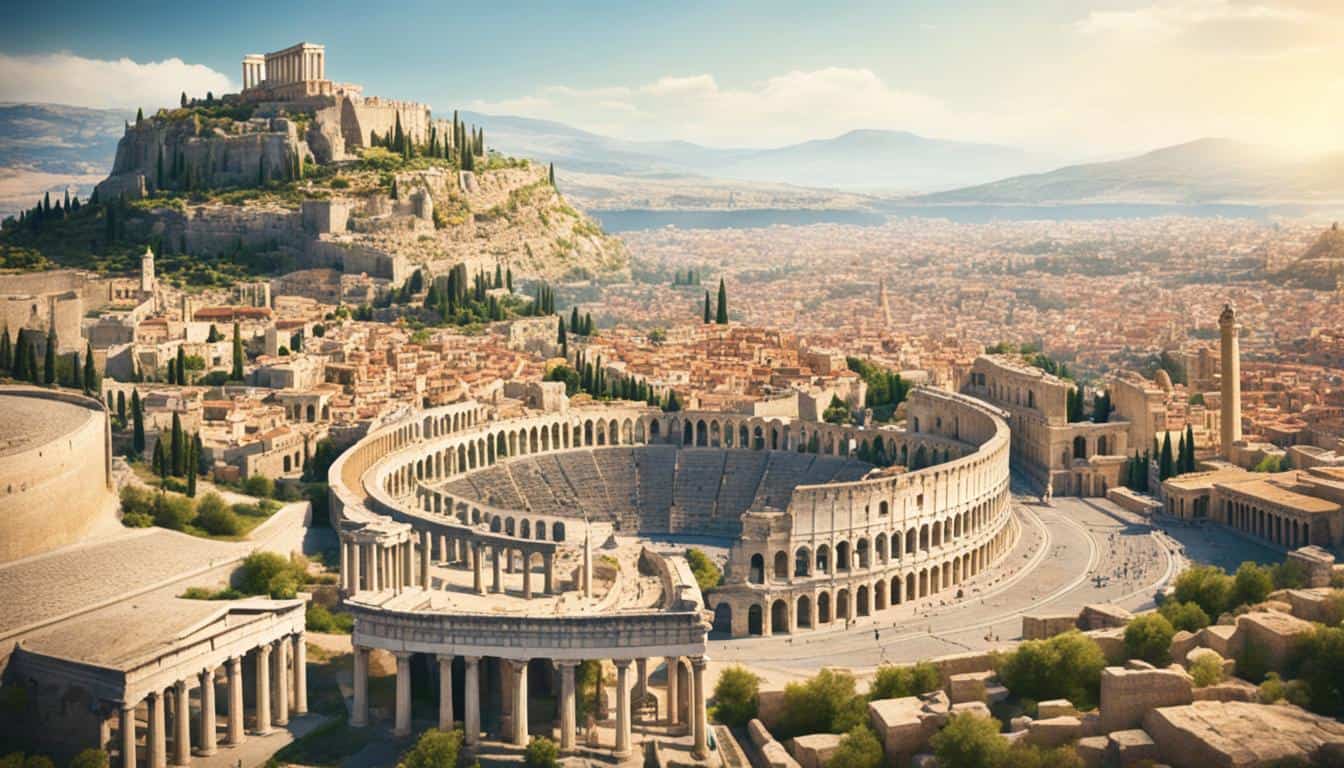Table of Contents
Have you wondered about Apostle Paul’s incredible journey? This key figure in early Christianity experienced a powerful change and then traveled to spread Jesus’ teachings. He visited many foreign cities along the way.
We’ll journey through cities like Damascus, Tarsus, and Jerusalem. We’ll explore how these places influenced Paul’s mission and legacy. Discover the historical and biblical importance of each city.
Our trip will be full of amazing stories and unexpected events. We’ll see miracles and learn about Paul’s faith and perseverance. Get ready to be inspired by Apostle Paul’s life.
Who’s excited to see where Apostle Paul made a big impact? Let’s start this journey together through these fascinating foreign cities.
Damascus, Syria
After his change of heart, Apostle Paul went on a big journey. He visited Arabia before coming back to the old city of Damascus (Galatians 1:17). Damascus, the capital of Syria, is known for its history and its connection to Paul’s life.
“In Damascus, Apostle Paul changed his life after meeting the risen Christ. This experience turned him into a follower of Christ and inspired him to spread Jesus’ teachings.”
Damascus was where Paul changed from hunting Christians to being a strong follower of Jesus.
Historical Significance
Damascus is one of the oldest cities in the world. It has always been an important place, being a key stop for traders. This made it a central hub for commerce and culture for many years.
In the Bible, Damascus is linked to major figures and events. It was on the road to Damascus that Saul, later Apostle Paul, changed his life. This moment is a big deal in the history of Christianity.
Apostle Paul’s Conversion
Saul was against Christians, but something huge happened in Damascus. A bright light from heaven appeared and he was left blind. He heard Jesus’ voice, and that changed his life. This marked the start of Paul’s journey.
After this change, Paul spent some time in Arabia. There, he probably learned more about the gospel and had important revelations (Galatians 1:17). When he came back to Damascus, he started his mission. His goal was to share the gospel with everyone, not just the Jews.
Explore Damascus
Today, visiting Damascus is a special experience. It mixes ancient biblical history with modern life. When you walk its streets, you can see places like the old Roman Street and the Umayyad Mosque.
This old city also has a lively market called Souq Al-Hamidiyya. It’s known for its bright colors, spicy smells, and handmade items.
| Key Highlights | Description |
|---|---|
| Umayyad Mosque | One of the oldest and most significant mosques in the world, featuring stunning architecture and historical artifacts. |
| Old City Walls | Explore the well-preserved ramparts and gates that once protected the city. |
| Souq Al-Hamidiyya | Indulge in a sensory experience while wandering through this bustling market, known for its vibrant colors, aromatic spices, and traditional handicrafts. |
Damascus is a fascinating mix of ancient wonders and a lively present. It shows the big changes faith can bring about. It also highlights the ongoing influence of Paul’s transformation.
Tarsus, Cilicia
After Apostle Paul’s time in Arabia, he came back to his hometown – Tarsus. This city is in the region of Cilicia (Acts 9:30). Tarsus is very important for us to know Paul better. His background and what shaped him come from here.
Tarsus was known far and wide for its culture and school. It was a key part of Paul becoming who he was. Being from Tarsus tells us a lot about Paul’s childhood and how it influenced him.
Tarsus sat on the east coast of the Mediterranean. This location made it a busy place for trading. People from all walks of life would come here, making it a very mixed and open place.
Tarsus was also famous for its schools. It even had a well-known Stoic philosophy school. This school impacted Paul’s ideas and gave him a strong start in thinking.
“I am indeed a Jew, born in Tarsus of Cilicia, but brought up in this city at the feet of Gamaliel, taught according to the strictness of our fathers’ law.” – Acts 22:3
In Tarsus, Paul saw many different cultures and learned many things. This varied learning helped him later when he spread the word about Christianity.
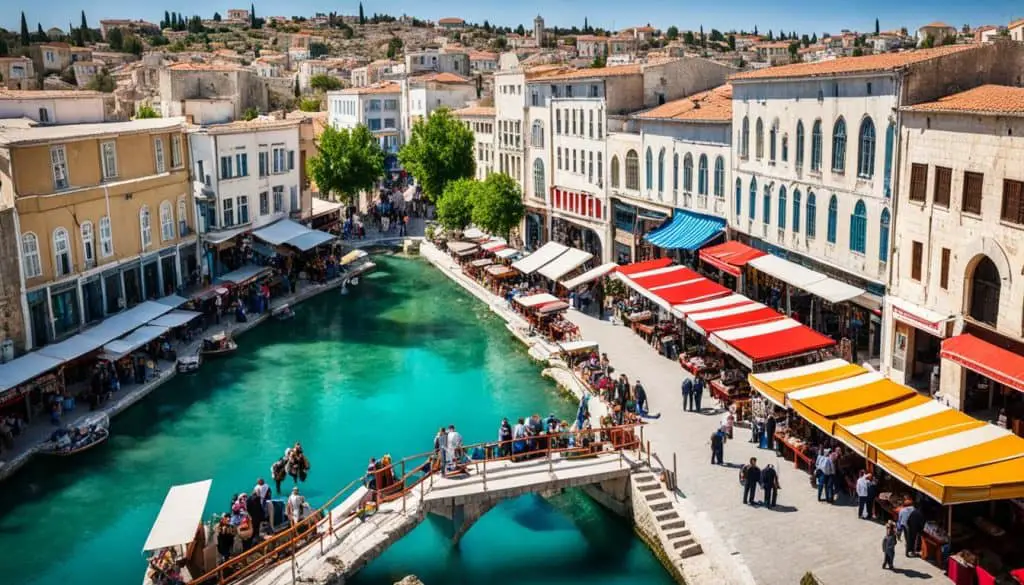
| Key Facts | Description |
|---|---|
| Location | Tarsus, Cilicia |
| Significance | Apostle Paul’s hometown and place of upbringing |
| Role | Shaped Paul’s background, education, and cultural influences |
| Cultural Exchange | Thriving trade city with diverse population and cosmopolitan atmosphere |
| Educational Institutions | Home to esteemed schools, including the Stoic philosophy school |
Jerusalem, Judea
After his conversion, Apostle Paul journeyed to Jerusalem, the holy city of Israel. It had been three years since he met Jesus on the road to Damascus. Now, Paul planned to visit Peter and James, two key early Christian leaders.(Galatians 1:18) This meeting with the church’s pillars was very important, influencing the future of Christian teachings.
Jerusalem was very important to Paul for religious reasons. It was the heart of Judaism and a place where many believers came on pilgrimages. The city was also where Jesus had died and come back to life. As a former strict Jew turned Christian, this visit to Jerusalem was a major moment. It confirmed his faith and tied him closer to the Christian community.
“In Jerusalem, I met with Peter and spent time with James, the Lord’s brother. This encounter served to strengthen my faith and confirm the authority of my apostleship.”
Paul must have had some deep talks with Peter and James while in Jerusalem. These discussions would have deepened his knowledge of Jesus’ teachings. Together, they probably established plans to spread the Christian faith. Peter and James’ advice in Jerusalem was key in shaping Paul’s mission trips and his later writings.(Galatians 2:2)
In his letter to the Galatians, Paul talked a lot about his Jerusalem visit. He stressed how important it was for his authority as an apostle. This trip was crucial for unity among Christians, whether they were Jews or from other groups. It helped the Christian message travel beyond Judea’s borders.
Key Takeaways:
- Jerusalem, the holy city of Israel, holds immense religious significance.
- Apostle Paul visited Jerusalem three years after his conversion to meet with Peter and James.
- This visit served to strengthen Paul’s faith and confirm his authority as an apostle.
- Jerusalem played a crucial role in shaping the future of Christian teachings.
| Location | Relevance |
|---|---|
| Jerusalem | Significant religious and historical importance, meeting with Peter and James |
Antioch, Syria
During Apostle Paul’s visit, Antioch, a lively city, became an important spot for his journeys. He found it in Syria. Antioch was key in spreading Christianity back then.
The place was full of different cultures and religions. This made it perfect for Paul to tell people about Christ. His message reached many, thanks to the city’s various people.
Here, in Acts 11:25-26, Paul got his mission. The Antioch church saw his skills and purpose. They sent him out to tell others about Jesus.
In Antioch, Paul was very focused on his work. He, along with Barnabas, spread Jesus’ message. They travelled to different parts preaching the gospel.
Antioch was their starting point. From there, Paul went on his first journey. He visited many places, teaching about Jesus. His time in Antioch laid the early Christian foundation.
The Impact of Antioch
In Antioch, Paul’s preaching started a faith movement. New churches formed, spreading across regions.
The city was strategic, perfect for spreading Paul’s teachings. Its place in trade routes helped connect people with the gospel. Antioch became a major spot for the early Christians.
Despite challenges, Paul kept going in Antioch. He faced different beliefs and pushbacks. But, his strong drive to share the gospel won over these challenges.
Antioch played a key role in early Christianity. Paul’s impactful work started there. Without it, the Christian story might have been different. It was a vital place for Paul and his team.
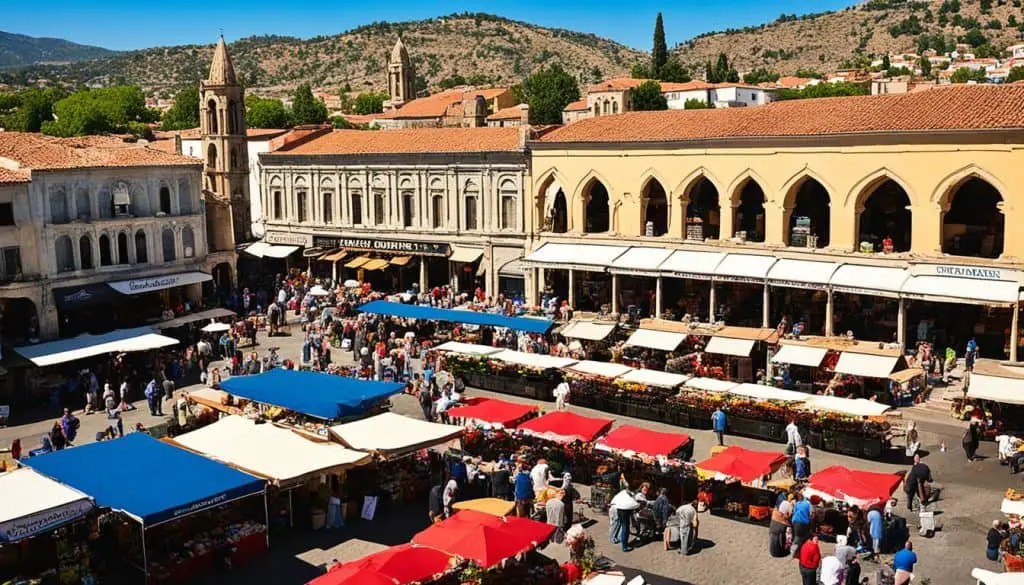
Salamis, Cyprus
Apostle Paul and Barnabas reached Salamis on their first journey. This city was at Cyprus’s beautiful heart (Acts 13:4). It marked the start of their work, spreading Jesus’ message there and beyond.
“For the word of God is alive and active. Sharper than any double-edged sword, it penetrates even to dividing soul and spirit, joints and marrow; it judges the thoughts and attitudes of the heart.” – Hebrews 4:12
Salamis sat on Cyprus’s east coast, famous for its busy harbor and key location. It was rich in history and drew from many cultures, welcoming people from around the globe.
Paul and Barnabas found a diverse mix of cultures and beliefs in Salamis. They worked to change traditional views by sharing Jesus’ teachings. The city’s many shrines were a stark comparison to the transformative power they talked about.
“For I am not ashamed of the gospel, because it is the power of God that brings salvation to everyone who believes…” – Romans 1:16
| Significance of Salamis, Cyprus | Key Takeaways |
|---|---|
| Historical importance | Salamis was an ancient city dating back to the 11th century BC, and it played a crucial role in the development of Cyprus. |
| Strategic location | The city’s position on the eastern coast of Cyprus made it an important hub for trade and commerce in the region. |
| Cultural diversity | Salamis was a melting pot of different cultures, with influences from Greek, Persian, Egyptian, and Roman civilizations. |
| Rich archaeological heritage | The ruins of ancient Salamis offer a glimpse into the city’s past, including its magnificent theater, baths, and agora. |
Starting in Salamis, Paul and Barnabas primed their mission’s reach. The experiences in Salamis shaped their evangelism. It laid the path for future journeys.
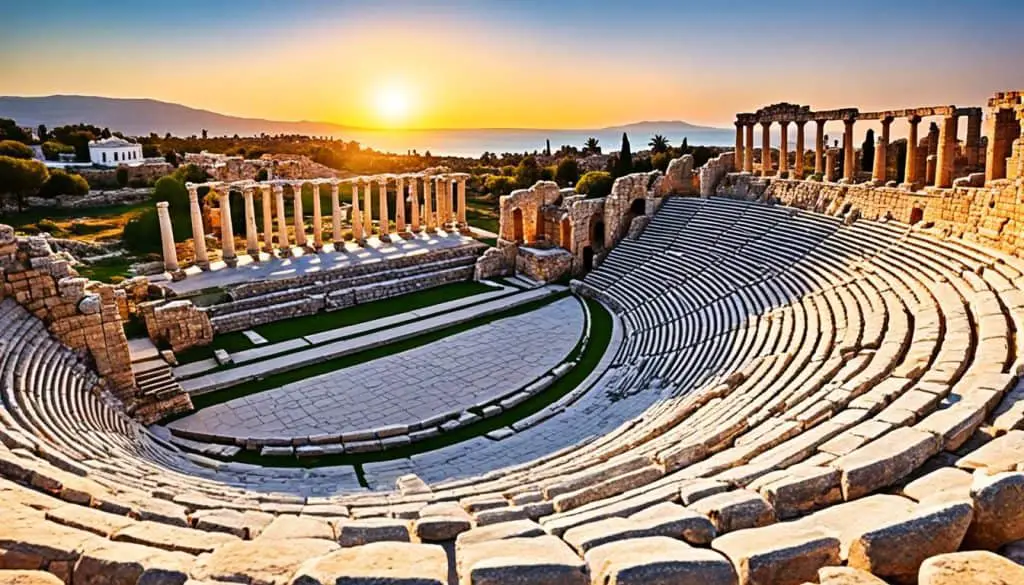
Exploring the Ruins of Salamis
Today, anyone can visit Cyprus and see Salamis’s ruins. It’s a chance to dive into the city’s ancient culture and history. The site features the remains of grand places like the theater and gymnasium, with the beautiful agora columns.
Walking through the ruins gives a feel for Salamis’s past vibrancy. It shows the continuing importance of this city and Paul’s early work.
We’re now off to the next city Paul visited: Paphos, Cyprus.
Paphos, Cyprus
Paul and Barnabas reached Paphos, a city on Cyprus’s southwest coast. It was known for its beauty and history. They decided it was a great place to share the word of Christianity.
In Paphos, they met a sorcerer. He tried to stop their mission after seeing the miracles Paul did. This put them in a tough spot.
Paul’s story in Paphos shows his strong faith. Even when faced with challenges, he never wavered. The sorcerer’s tricks couldn’t break his connection with God.
Paphos was special for its religious and cultural background. It was famous for being the place where Aphrodite, the goddess of love, was born. This made it a good spot for Paul and Barnabas to talk about Christianity’s power.

The Cultural Brilliance of Paphos
Paphos was filled with spiritual and divine moments. Its temples, villas, and theaters drew many visitors. These places added to Paphos’s charm.
Paul and the sorcerer’s encounter showed a big difference in beliefs. The sorcerer stood for old practices, while Paul presented Christianity. This contrast made Paphos even more key in history, linking old traditions with new faiths.
Legacy and Significance
The event in Paphos inspired many. Paul’s strength in his belief and the effect of his message were clear to all. People saw what real change his message could bring.
This moment was big for Paul’s work in spreading Christianity. It was key in his journey. Paphos taught him much, helping him and Barnabas in teachings ahead. They continued spreading the Gospel with these lessons close to heart.
Perga, Pamphylia
Paul and Barnabas made it to Perga in Pamphylia, but John Mark decided to stay behind (Acts 13:13). This city was vital in Apostle Paul’s mission. It was a significant place on their journey.
When they arrived, John Mark chose to leave them. The exact reason for his leaving is not clear. But it surely affected their work a lot.
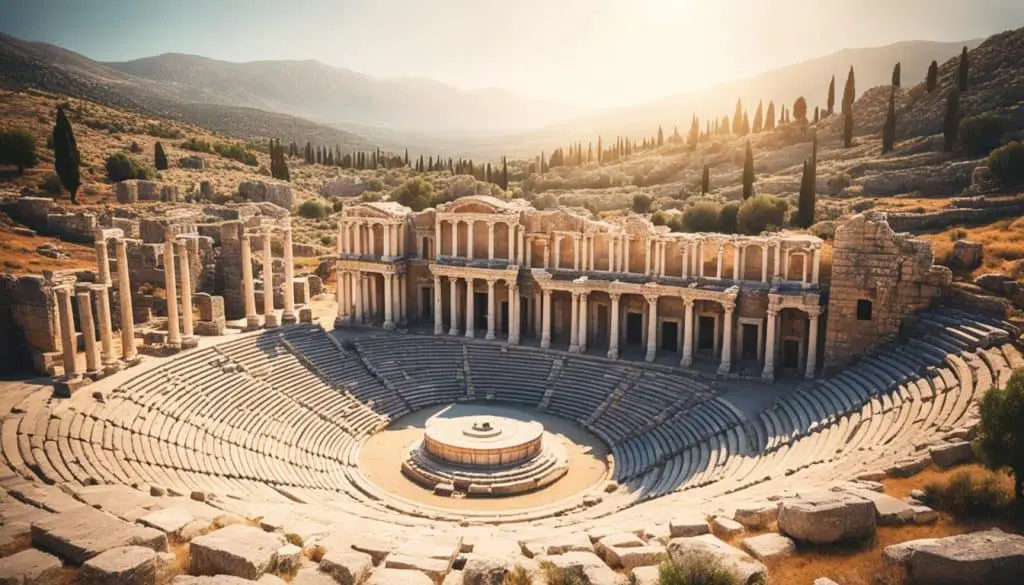
Perga is on the southern coast of what is now Turkey. It was a busy and important maritime city. Perga had a lively market and was home to many cultures. This made it a key place for trade.
In Perga, Paul and Barnabas would meet people from various backgrounds. They likely heard different languages and saw various beliefs. This mix could help or challenge their Christian teachings.
Antioch, Pisidia
Pisidia, in Asia Minor, was a key place for Paul’s missions. Him and Barnabas went there, spreading Jesus’ teachings in Antioch. Some Jews didn’t like what they were preaching.
But Paul and Barnabas weren’t discouraged. They bravely talked about Jesus to everyone. Their messages attracted a big group, including both Jews and Gentiles.
“Therefore, my friends, I want you to know that through Jesus the forgiveness of sins is proclaimed to you” (Acts 13:38).
They spoke about how Jesus could change lives. They offered hope and freedom to all who would believe. They urged the people in Antioch to trust in Jesus for salvation.
The Opposition Faced
Not everyone welcomed their message, though. Some Jews were jealous and didn’t believe them. They caused trouble and tried to hurt Paul and Barnabas’s work.
Even with problems, Paul and Barnabas kept going. They were strong and kept sharing God’s word, even arguing with their opponents.
“We had to speak the word of God to you first. Since you reject it and do not consider yourselves worthy of eternal life, we now turn to the Gentiles” (Acts 13:46).
Paul and Barnabas then decided to focus on the Gentiles. This move was a big moment for spreading Christianity. It showed that the message of Jesus was for everyone.
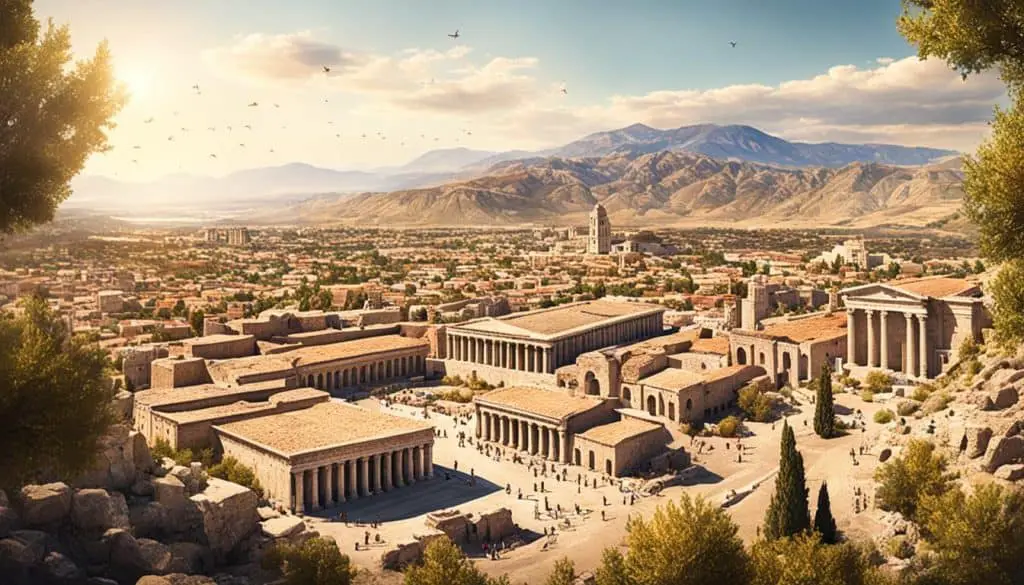
The city of Antioch was a central point of early Christianity. Paul and Barnabas found a mixed crowd there, perfect for their mission. Despite difficulties, they shared the Gospel courageously. Their work in Antioch had a lasting effect, helping Christianity grow in the region.
Iconium, Lycaonia
Paul and Barnabas journeyed to Iconium in Lycaonia. There, they started a church and faced persecution.1 Iconium was bustling with trade, making it perfect for introducing Christianity.
![]()
The duo’s work in Iconium was key in their mission. Even though they met opposition, they shared Jesus Christ’s teachings.
The trade hub attracted many. This let Paul and Barnabas speak to a wide group about faith. People were moved by their words and deeds, and a community of believers formed1.
But not everyone welcomed their message. Local Jews and Gentiles tried to stop them. They tried to weaken Paul and Barnabas’ influence1.
| Iconium, Lycaonia | Establishment of a Church | Persecution |
|---|---|---|
| Populous city | Paul and Barnabas establish a church | Opposition from some Jews and Gentiles |
| Vibrant trade scene | Preaching and miracles attract followers | Attempts to undermine their influence |
| Diverse audience | Message of faith spreads among the people | Persecution intensifies |
In spite of the hardships, Paul and Barnabas kept their faith. They continued to spread their message, uplifting their followers through challenges.1
Iconium stood out in Paul’s journey. It showed both success in building churches and the persecution Christians faced.
[Iconium, Lycaonia]
1. Bible, Acts 14:1-7
How did Apostle Paul’s travels to foreign cities impact early Christianity’s interaction with Roman policies?
Apostle Paul’s travels to foreign cities played a pivotal role in shaping early Christianity’s interaction with Roman policies. His missionary journeys helped spread the teachings of Jesus to various regions, leading to new communities of believers. This expansion forced early Christianity to navigate and adapt to a variety of Roman policies.
Lystra, Lycaonia
Apostle Paul and Barnabas went to Lystra, a small city in Lycaonia. There, Paul healed a man who couldn’t walk. The locals were amazed by this miracle.
In Lystra, different cultures mixed together. When they saw Paul and Barnabas heal, the people thought they were gods. They believed something divine had happened among them.
Paul and Barnabas explained they were not gods, but were sharing the message of the true God. Even though they were praised, they didn’t see themselves as divine. They shared their faith with the people there.
Thinking about Paul’s time in Lystra shows us how powerful God’s miracles are. It also teaches us the importance of spreading the truth. Paul’s story inspires us to show kindness, talk about our faith, and follow our calling from God.

